Variations in designers’ preferences and a system’s needs shape fire sprinkler riser assemblies—but many can be simplified with pre-made manifolds
In part one of this series, we explained how the essential components of a fire riser are used to streamline repairs and verify the fitness of a fire sprinkler system. In this article, we explain how these other common components come together to form specific types of fire sprinkler riser assemblies for wet-pipe systems. Along the way, we’ll answer an important question facing contractors: when should risers be constructed using prefabricated manifolds rather than fully assembled in the field?
This article references standards from the National Fire Protection Association (NFPA). Many jurisdictions have adopted these documents and their stipulations as law, including their standards for commercial sprinkler systems (NFPA 13), multi-family residential systems (NFPA 13R), and home fire sprinkler systems (NFPA 13D).
For more on NFPA standards and their role in American fire protection, check out “The History of Life Safety Code: NFPA 101, NFPA 13, NFPA 13R, and NFPA 13D.”
You can also check out our extensive line-up of pre-assembled commercial and residential riser manifolds, pressure gauges, test, drain, and trim valves, and flow and pressure switches.
Check valves may or may not be installed at fire risers
Both check valves and alarm check valves at the fire riser may satisfy NFPA 13 requirements
Check valves are a common (but not universal) feature of fire sprinkler risers. They prevent the contents of a sprinkler system—from the riser and connected piping—from flowing out of sprinkler pipes and into the municipal water supply, water tanks, or another source. In wet-pipe systems, they also prevent a loss of pressure downstream.
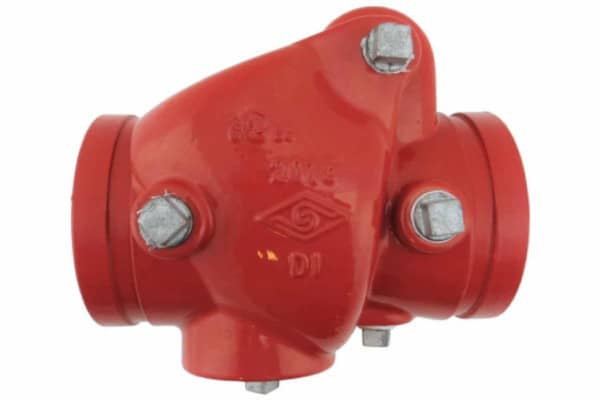
One check valve will almost always be found at the fire sprinkler riser: an alarm valve, or alarm check valve. In wet-pipe systems, an alarm check valve has a port that fills with water when a fire sprinkler head activates.
That water can power a motorized alarm bell or activate a pressure switch connected to an alarm bell or fire alarm control panel. The 2019 edition of NFPA 13 states that no additional check valves are required for a single wet-pipe system if it has both a fire department connection and an alarm valve attached (see section 16.9.5.5).
Check valves—not required for NFPA 13R or 13D systems—may be absent from commercial fire risers when potable and non-potable water sources threaten to mix
Check valves prevent backflow. But backflow preventers can use multiple check valves, air vents, and other devices to defend against cross-contamination more rigorously. In NFPA 13 systems, a backflow preventer may serve as the check valve for multiple risers joined as a single manifold (16.9.5.2). In section A.5.1.8, NFPA 13 recommends—but does not require—that these devices be installed in two scenarios:
- Systems connected directly to a public water supply and at least one tank or covered reservoir filled with public, potable, and maintained water.
- Systems containing antifreeze or other solutions, along with systems supplied by public water mains and a non-potable source of water such as a pond or contaminated river.
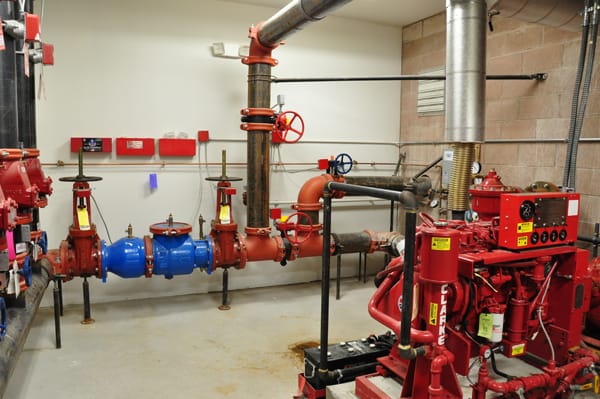
When a fire sprinkler system relies on a mix of potable and non-potable water sources—or when water authorities are particularly worried about backflow—there’s a good chance a backflow preventer is installed. In these situations, it’s possible that check valves won’t be found at the system riser.
In residential fire sprinkler systems under NFPA 13R and NFPA 13D, neither check valves nor backflow preventers are required. However, local laws may require backflow preventers. If they’re included—and listed for fire protection service—they may act as both a control and check valve for the system, eliminating the need for additional devices at the riser.
Pressure-reducing and pressure relief valves may be included with fire sprinkler riser assemblies when necessary and convenient
In commercial systems, valves that regulate pressure sometimes connect to riser trim
Pressure-reducing valves lower the pressure of the water passing through them, preventing damage to sprinkler system components. Are they located at the fire riser in NFPA 13 systems? Not always. Often, they are used locally to minimize pressure on the lower floors of buildings when higher overall pressure is needed to reach higher floors and deliver appropriate pressure. In systems or portions of systems where pressure is likely to exceed 175 PSI—and some components aren’t listed for pressures that high—a listed pressure-reducing valve set at 165 PSI is required.
When installed, these valves require gauges on both the inlet and outlet side, along with a listed relief valve at least 1/2” in size on the discharge size of the valve. And unless the pressure-reducing valve is listed as a control (indicating) valve, an additional control valve must be provided on the inlet side.
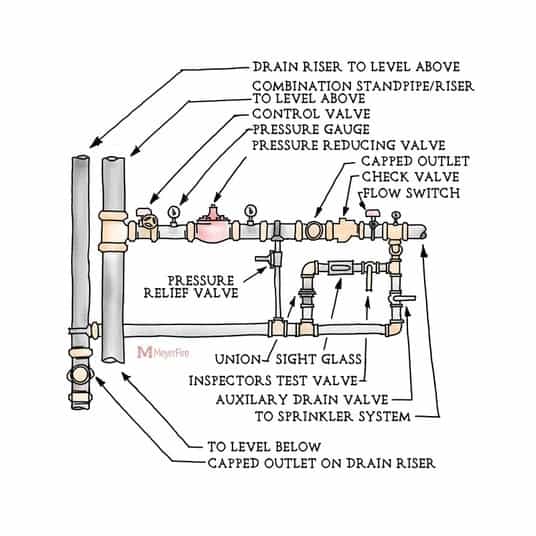
Listed relief valves are required on all NFPA 13 wet-pipe systems, save for those that have auxiliary air reservoirs. Such valves may be placed at the riser; however, NFPA 13 does not specify an exact location. These valves must also be at least 1/2” in size and must operate when pressures reach 175 PSI or 10 PSI in excess of the maximum system pressure (when that’s greater).
For more on these requirements, take a look at NFPA 13 (2019), sections 8.1.2, 8.3.2.4.3, and 16.9.8.
Pressure-reducing valves may be found with residential fire risers when higher pressures put pipes and fittings at risk
In NFPA 13R systems, valves that reduce pressure for a combined domestic water and fire protection supply system do not need to be listed for fire protection. However, pressure reducing valves serving only the sprinkler system must be listed. Gauges approved by the authority having jurisdiction (AHJ) must be installed on the inlet and outlet side of each pressure-reducing valve when they’re installed.
Home fire sprinkler systems under NFPA 13D have slightly different requirements. These systems need a pressure-reducing valve if:
- They use nonmetallic pipe
- Don’t have a fire department connection
- And the maximum static pressure from the water supply exceeds 80 PSI
A similar rule applies if, instead of nonmetallic pipe, the system uses nonmetallic fittings. There’s one difference, though: installers must place “an automatic means of pressure relief”—or a pressure relief valve—on the system side of the included pressure-reducing valve.
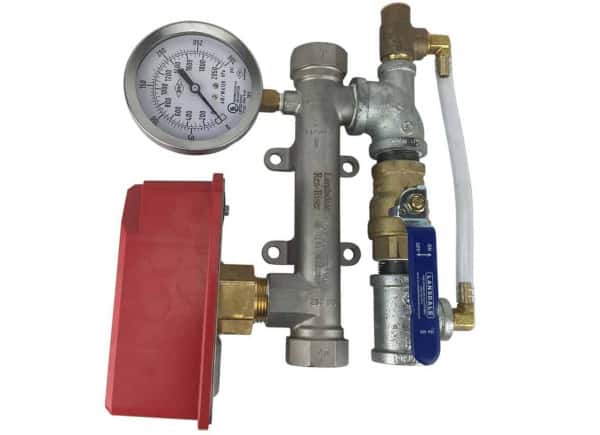
For more on these requirements, see:
- NFPA 13R (2016): 5.1.2
- NFPA 13D (2016): 5.2.2.4, 5.2.2.4.1, 5.2.5.4.2
A few types of commercial, residential, and home fire sprinkler riser assemblies may be used in the most common scenarios
NFPA 13 risers
There are two standard configurations for fire sprinkler risers installed in NFPA 13 systems:
- Straight risers
- Alarm check risers
Both feature a control valve, a main drain, an alarm bell, a way of sounding an alarm when the fire sprinkler system activates, and pressure gauges. These types of fire riser vary largely in the way they meet NFPA 13’s requirements to sound an alarm when a sprinkler or sprinklers activate.
Straight risers don’t have an alarm check valve. The most basic types—installed when there’s a backflow preventer on the fire service main—don’t even have a check valve. As mentioned earlier, these backflow preventers may already be present when local law requires it or when the system relies on a combination of municipal water supplies and other water sources. To sound an alarm, a straight riser uses a vane-type flow switch (see part one of this series for more on this) connected electronically to a fire alarm bell. This switch installs downstream of the check or control valves.
An alarm check riser has (as the name suggests) an alarm check valve. They can also use a vane-type flow switch. However, an alarm check valve allows for the use of pressure switches. These switches connect to trim piping on the valve—with or without a retard chamber—rather than the riser itself. This configuration allows switches to be replaced without draining pipes downstream and tested without flowing water through the entire system. They also allow for the use of a water motor gong, a type of mechanical bell that sounds using water pressure rather than electricity.
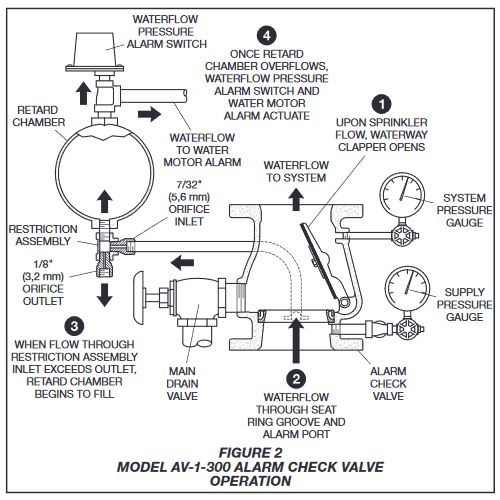
For a detailed (and lengthy) introduction to commercial wet-pipe risers, we recommend that you watch Ben Stewart—a fire protection engineer with Western States Fire Protection—in a teaching session with new sprinkler system designers.
NFPA 13R and 13D wet-pipe fire risers are much simpler (and smaller) than NFPA 13 risers
How do residential fire sprinkler risers differ from their commercial counterparts? One significant difference is evident just by looking at some prefabricated riser kits: commercial kits have pipe sizes of at least 2” while many residential kits are in the range of 1”-2”. These smaller assemblies also tend to rely on pipes with threaded—rather than grooved—ends.
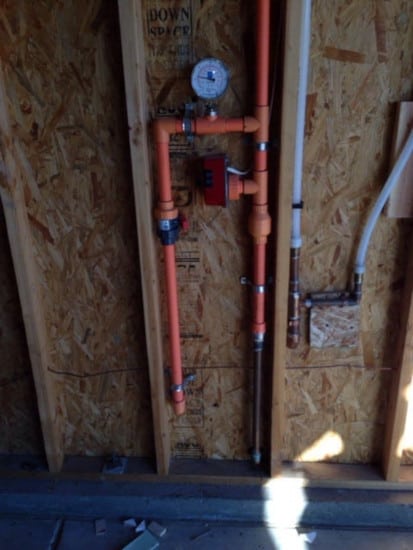
To illustrate the simplicity of these risers, take a look at the photograph above. It’s NFPA 13D’s mission to make home sprinkler systems affordable and easy to install—and here, they seem to have done exactly that. Assuming that what we’re seeing is part of an NFPA 13D-compliant system, we can tell that this riser:
- Has no check valve (and doesn’t need one)
- Has no pressure relief or reducing valve—at least at the riser
- May have the required drain valve of 1/2” or larger (center-left)
- May have a single control valve controlling the sprinkler system and domestic piping
- Includes an optional gauge
Costs for prefabricated fire riser manifolds can compete with do-it-yourself installations
Prefabricated fire risers for commercial wet-pipe sprinkler systems generally feature:
- A short length of riser piping
- A flow switch
- The system-side pressure gauge and a three-way valve to turn it on and off
- A drain valve or test and drain valve
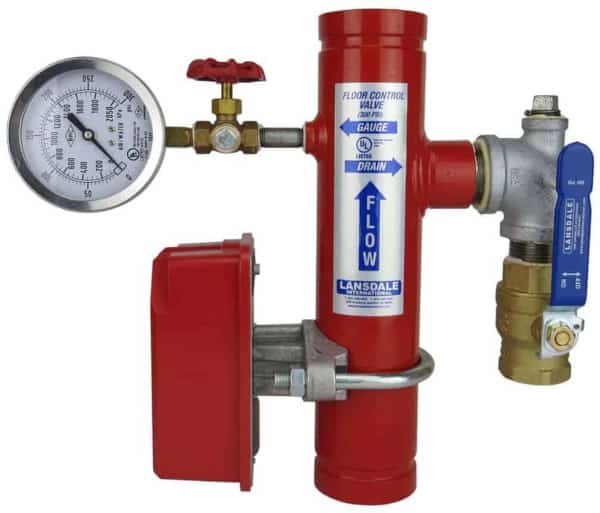
How do the costs of these commercial risers compare to the cost of the raw materials? Let’s look at an example of a 4” riser assembly. With the exception of items marked with an asterisk, these items are as priced at QRFS (others found at competitive prices online):
- System Sensor’s WFD40N Flow Switch: $122.95
- 2” Lansdale Test & Drain Valve: $213.95
- 1/4” Brass Three-Way Valve: $6.95
- 0-300 PSI Air/Water Pressure Gauge (3 1/2” Dial): $72.95
- 2” Galvanized Elbow for Drain Valve (90 Degrees): $24.01*
- 1/4” Black Steel Pipe Nipple for Pressure Gauge (2” Long): $1.58*
- 2” Black Steel Pipe Nipple (Close): $4.12*
- 4” A53 Schedule 40 Grooved Pipe (13” Long): $29.88*
Retail cost of non-assembled parts for 4” commercial riser assembly: $476.39
Retail cost of 4” commercial riser assembly: $443.95
In many cases, prefabricated parts cost more upfront—but they compensate by reducing the time required for assembly. But this 4” commercial riser has both advantages: reducing contractors’ material and labor costs. And contractors looking to assemble their own need even more parts: namely, the mechanical tees needed to provide threaded connections for the three-way valve and the nipple/elbow combination leading to the test and drain valve.
This combination of components, while common, may not be ideal for some risers. The system-side gauges often mount to trim attached directly to the alarm valve. And if installers opt to use pressure switches—whether installed with a retard chamber or with a built-in retard—the flow switch becomes unnecessary. However, these assemblies are a strong candidate for use with straight riser assemblies, where the attached gauge and flow switch are in a suitable position.
The principles behind fire sprinkler system risers are simple, but execution can be tricky
Risers, whether they’re built from scratch or with a mix of manifolds and other parts, play a critical role in keeping a fire sprinkler system operational. And while contractors have a far easier time constructing wet-pipe residential risers than they do commercial risers, all three types serve the same purpose: keeping pressure at acceptable limits, making repairs possible, and providing water to sprinklers.
This concludes part two of our look at fire riser components. Stay tuned for future installments, where we tackle the challenges of fabricating risers for dry, preaction, deluge, combination, and other sprinkler systems. We also invite you to view our collection of riser components, including:
- Pre-assembled commercial and residential riser kits
- Air and water pressure gauges and matching three-way valves
- Drain valves, such as ball valves and test and drain valves
- Control valves, including butterfly valves and OS&Y valves
- Flow and pressure switches from System Sensor
- Mechanical tees for connecting riser components to grooved pipes, along with specialty hole-cutting tools
Questions? Looking for a component to round out your fire sprinkler system riser assembly? Let us help. Call us at +1 (888) 361-6662 or email support@qrfs.com.
This blog was originally posted at blog.qrfs.com. If this article helped you, check us out at Facebook.com/QuickResponseFireSupply or on Twitter @QuickResponseFS.


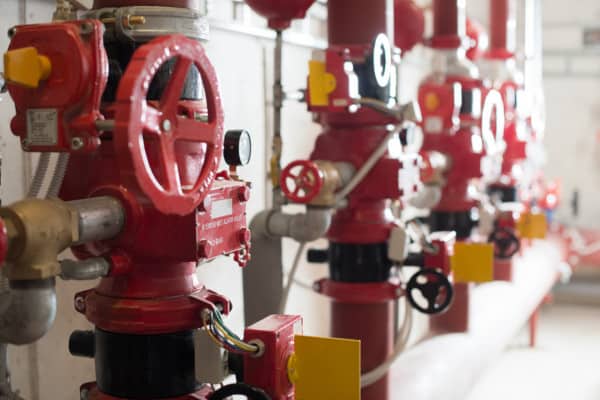
I am going through a job right now in 13D and I am being told by my current supervisor a check valve is needed on the system riser for each unit of our building. I was once told it was not needed by my previous supervisor. I currently have a control valve, and flow switch on the riser with the underground having a backflow. The underground only feeds the fire line (no domestic). I am just having a hard time explaining as to why a check valve wont be needed on the riser and I cant find it stating this in NFPA 13D.
Randy – For system, standards, and code questions like this, you can try our Ask a Fire Pro service. Click the link to submit your question with some information about your building and system, and a fire protection professional will provide an answer based on best practices, standards, and codes. Our pros include AHJs, contractors, engineers, and code experts with 150+ years of combined experience!